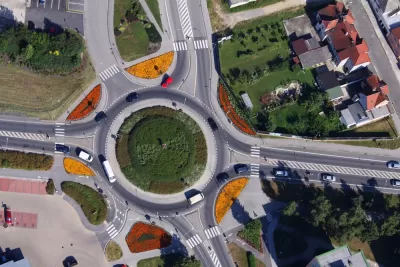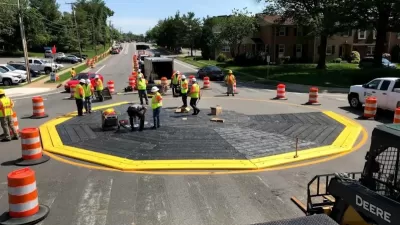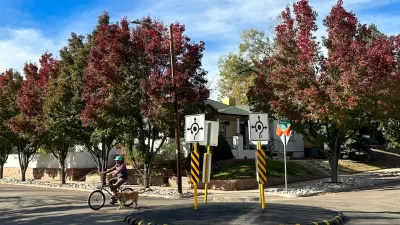Roundabouts, which can dramatically improve traffic safety, have been slowly proliferating across U.S. cities over the last two decades.

Although a lack of federal data makes it difficult to evaluate the scale of their growth, roundabouts and traffic circles are slowly but surely making their way into American cities, writes Andrew Van Dam in the Washington Post.
According to Lee Rodegerdts, who literally wrote the book on roundabouts—Roundabouts: An Informational Guide—there are now roughly 9,000 roundabouts around the country, plus over 160 rotaries and more than 700 traffic-calming circles.
Florida boasts the most roundabouts, but it also has the third-largest population in the nation. Nebraska has the most roundabouts per person, but they’re spread across one of the sparsest (and often most scenic) road networks in the country. Per mile of road, Maryland actually emerges as the roundabout champion.
As far as cities go, the wealthy enclave of Carmel, just outside Indianapolis, has more roundabouts than any other U.S. locality thanks to its long-term mayor, who has championed roundabouts for decades. Carmel has built more than 140 roundabouts under his tenure.
“Why add a roundabout, you might ask. Because roundabouts offer impressive safety gains. In general, a roundabout will drive down fatal crashes by 90 percent and cut all car-crash injuries by at least 75 percent, even while accommodating a higher volume of cars.” The benefit is even greater at rural two-way stops, cutting traffic injuries by as much as 90 percent.
FULL STORY: The rise of the roundabout and which state has the most

Maui's Vacation Rental Debate Turns Ugly
Verbal attacks, misinformation campaigns and fistfights plague a high-stakes debate to convert thousands of vacation rentals into long-term housing.

Planetizen Federal Action Tracker
A weekly monitor of how Trump’s orders and actions are impacting planners and planning in America.

San Francisco Suspends Traffic Calming Amidst Record Deaths
Citing “a challenging fiscal landscape,” the city will cease the program on the heels of 42 traffic deaths, including 24 pedestrians.

Defunct Pittsburgh Power Plant to Become Residential Tower
A decommissioned steam heat plant will be redeveloped into almost 100 affordable housing units.

Trump Prompts Restructuring of Transportation Research Board in “Unprecedented Overreach”
The TRB has eliminated more than half of its committees including those focused on climate, equity, and cities.

Amtrak Rolls Out New Orleans to Alabama “Mardi Gras” Train
The new service will operate morning and evening departures between Mobile and New Orleans.
Urban Design for Planners 1: Software Tools
This six-course series explores essential urban design concepts using open source software and equips planners with the tools they need to participate fully in the urban design process.
Planning for Universal Design
Learn the tools for implementing Universal Design in planning regulations.
Heyer Gruel & Associates PA
JM Goldson LLC
Custer County Colorado
City of Camden Redevelopment Agency
City of Astoria
Transportation Research & Education Center (TREC) at Portland State University
Jefferson Parish Government
Camden Redevelopment Agency
City of Claremont





























